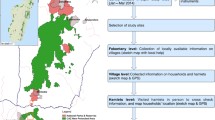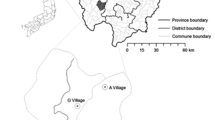Abstract
This descriptive study identifies patterns of land use among small farmer settlers in the Northeastern Ecuadorian Amazon using cross-sectional data collected among approximately 400 households in 1990. A “typology” of land use patterns is built and considered in relation to two household characteristics: duration of settlement and labor. Several variations in land use patterns are identified according to the degree of forest clearing they involve. Findings suggest that most settlers reflect a low cleared area pattern which may be related to a “brake” family-based coffee production cleared and places on the area cultivated. Reducing clearing by settlers already in the region may therefore mean reinforcing what most are already doing. However, since lower welfare may be associated with lower cleared areas patterns, reinforcing their use will involve making them more profitable. Improving the well-being of the human as well as natural resources of the Amazon frontier will inevitably entail policy measures which reconcile the needs of settler households with forest conservation.
Similar content being viewed by others
REFERENCES
Almeida, A. L. O. de (1992). The Colonization of the Amazon. University of Texas Press, Austin.
Barral, H. (1986). Usos Del Suelo en la Amazonia Ecuatoriana (Napo). ORSTOM, Ecuador.
Bromley, R. (1981). The colonization of humid tropical areas in Ecuador. Singapore Journal of Tropical Geography 2(2): 15-25.
Brondizio, E., Morán, E., Mausel, P., and Wu, Y. (1994). Land use change in the Amazon estuary: Patterns of Caboclo settlement and landscape management. Human Ecology 22(3).
Center for Economic and Social Rights (CESR) (1994). Rights Violations in the Ecuadorian Amazon: the Human Consequences of Oil Development. CESR, New York.
Centro de Estudio de Población y Paternidad Responsable (CEPAR) (1993). Perfil Socio-demograpfico de las Regiones: Amazónica e Insular. CEPAR, Quito.
Dale, V. H. (1994). Modeling effects of land managment in the Brazilian Amazonian settlement of Rondonia. Conservation Biology 8(1): 196-206.
Estrada, R. D., Seré, C., and Luzuriaga, H. (1988). Sistemas de Producción Agrosilvopastoriles and la Selva Baja de la Provincia del Napo, Ecuador. CIAT, Cali, Colombia.
Fearnside, P. (1990). Environmental destruction in the Brazilian Amazon. In Goodman, D., Hall, A. (eds.), The Future of Amazonia: Destruction or Sustainable Development. St. Martin's Press, New York.
Fujisaka, S. (1995). Slash and Burn Agriculture and Deforestation in Pedro Peixoto Acre, and Theobrama, Rondonia, Brazil. Report for the Inter-American Development Bank Funded Project, A diagnostic study of agricultural land use in the southwest Brazilian Amazon, March 13.
Furley, P. A. (ed.) (1994). The Forest Frontier: Settlement and Change in Brazilian Roraima. Routledge, London and New York.
Gonard, P., León, J. B., Sylva Ch. P. (1988). Transformaciones agrarias en el Ecuador. In Geografía Basica del Ecuador: Tomo Geografía Agraria (Vol. 1). Centro Ecuatoriana de Investigación Geográfica (CEDIG), Quito, Ecuador.
Goodman, D., and Hall, A. (eds.) (1990). The Future of Amazonia: Destruction or Sustainable Development. St. Martin's Press, New York.
Hicks, J. (1990). Ecuadors Amazon Region: Development Issues and Option. World Bank Discussion Paper, Number 75, The World Bank, Washington, D.C.
Kimmerling, J. (1993). Crudo Amazónico. Ediciones Abya-Yala, Quito, Ecuador.
Marquette, C. M., and Bilsborrow, R. (1997). The cutting edge: Household dynamics and deforestation among settlers in the Northeastern Ecuadorian Amazon. Human Organization (Paper under review).
Morán, E. (1984). Colonization in the Transamazon and Rondonia. In Schmink, M., and Wood, C. (ed.), Frontier Expansion in Amazonia. University of Florida Press, Gainsville, pp. 285-306.
Morán, E. (1989). Adaptation and maladptation in newly settled areas. In Schumann, D. A., and Partridge, W. L. (eds.), The Human Ecology of Tropical Land Settlement in Latin America. Westview Press, Boulder, CO, pp. 20-42.
Morán, E. (1993). Deforestation and land use in the Brazilian Amazon. Human Ecology, 21(1): 1-21.
Murphy, L., Bilsborrow, R., and Pichón, F. (1997). Poverty and Prosperity Among Migrant Settlers in the Amazon Rainforest Frontier of Ecuador. Unpublished paper, Carolina Population Center, University of North Carolina, Chapel Hill.
Pichón, F. (1996a). Settler agricultural and the dynamics of resource allocation in frontier environments. Human Ecology 24(3).
Pichón, F. (1996b). Land use strategies in the Amazon frontier: Farm-level evidence from Ecuador. Human Organization 55(4).
Pichón, F. (1996c). The forest conservation process. Agricultural and Human Values 13(1).
Pichón, F. (1997a). Colonist land allocation decisions, land use and deforestation in the Eucadorian Amazon frontier. Economic Development and Cultural Change 45(3).
Pichón, F. (1997b). Settler households and land-use strategies in the Amazon frontier: Farmlevel evidence from Ecuador. World Development 25(1).
Pichón, F., and Marquette, C. M. (1997). Ecuador's tropical forest frontiers: Some historical and recent aspects of settlement and agricultural expansion. Iberoamerica Nordic Journal of Latin American Studies XXVII( in press).
Rudel, T. K., and Horowitz, B. (1993). Tropical Deforestation: Small Farmers and Land Clearing in the Ecuadorian Amazon. Columbia University Press, New York.
Salaberría, J. M. (1990). Napo: Subdesarrollo Evitable. Fundación Interayuda, Quito, Ecuador.
Schmink, M. and Wood, C. (1992). Contested Frontier in Amazonia. Columbia University Press, New York.
Schneider, R. R. (1995). Government and Economy on the Amazon Frontier. World Bank Environment Paper, No. 11, The World Bank, Washington, D.C.
Schumann, D. A., and Partridge, W. L. (1989). The Human Ecology of Tropical Land Settlement in Latin America. Westview Press, Boulder, CO.
Southgate, D. (1992). Tropical Deforestation and Agricultural Development in Latin America. London Environmental Economic Centre Dicussion Paper No. 91-01, LEEC, London.
Southgate, D., Sierra, R., and Brown, L. (1991). The causes of tropical deforestation in Ecuador: A statistical analysis. World Development 19(9): 1145-1151.
Southgate, D., and Whittaker, M. (1994). Tropical deforestation. In Southgate, D., and Whittaker, M.Economic Progress and the Environment: One Developing Country's Policy Crisis. Oxford University Press, New York and Oxford, pp. 33-45.
Syndenstricker, J., and Vosti, S. (1993). Household Size, Sex Composition, and Land Use in the Tropic Moist Forests: Evidence from Macadinho Colonization Project in Rondonia Brazil. Paper presented at the Annual Mee ting of the Population Association of America, Cincinatti, Ohio, April 1-3.
Trujillo, J. (1988). Los Pueblos Indígenas e el Proceso Colonizador en la Región Amazónica Ecuatoriana: Diagnóstico Analítico. Intituto Latinoamericano de Investigaciones Sociales (ILDIS), Quito, Ecuador.
United States Agency for International Development (USAID/Quito) (1989). An Assessment of Biological Diversity and Tropical Forests in Ecuador. Paper prepared for USAID/Quito as an Annex to the Country Development Strategy for Federal Year 1989-1990.
Uquillas, J. (1984). Colonization and spontaneous settlement in the Ecuadorian Amazon. In Schmink, M., and Woods, C. (eds.), Frontier Expansion in Amazonia. University of Florida Press, Gainsville, FL.
Wood, C. (1993). Population and Land Use Change in the Brazilian Amazon. Paper presented at the Forum on Population, Environnment, and Development, Rene Dubois Center for Human Environments Inc., New York, September, 22-23.
World Bank (1992). Brazil: An Analysis of Environmental Problems in the Amazon. Internal Discussion Paper: World Bank, Latin American and Caribbean Region. Report No. 9104-BR, World Bank, Washington D.C.
Zaidi, S. (1994). Human Health Effects of Oil Development in the Ecuadorian Amazon: a Challenge to Legal Thinking. Environmental Impact Assessment Review. 14: 337-348.
Rights and permissions
About this article
Cite this article
Marquette, C.M. Land Use Patterns Among Small Farmer Settlers in the Northeastern Ecuadorian Amazon. Human Ecology 26, 573–598 (1998). https://doi.org/10.1023/A:1018797325069
Issue Date:
DOI: https://doi.org/10.1023/A:1018797325069




